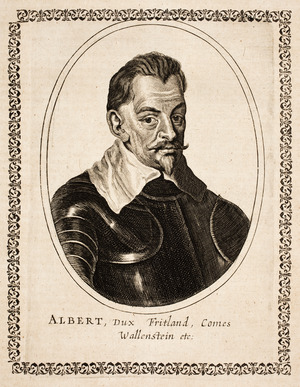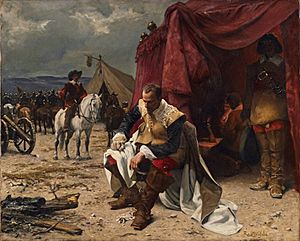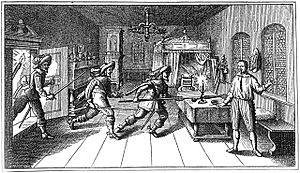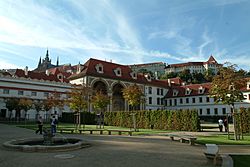Albrecht von Wallenstein facts for kids
Quick facts for kids
Albrecht von Wallenstein
Duke of Friedland
|
|
|---|---|
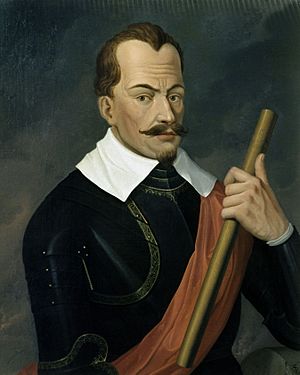
Portrait by Anthony van Dyck, 1629
|
|
| Birth name | Albrecht Wenzel Eusebius von Wallenstein |
| Born | 24 September 1583 (Old style: 14 September) Heřmanice, Bohemia |
| Died | 25 February 1634 (aged 50) Cheb, Bohemia |
| Buried |
Mnichovo Hradiště, Bohemia
|
| Allegiance | Catholic League |
| Branch | Imperial Army (Holy Roman Empire) |
| Years of service | 1604–1634 |
| Rank | Generalissimo |
| Battles/wars | Long Turkish War Uskok War • Battle of White Mountain (1620)
• Battle of Dessau Bridge (1626) • Siege of Stralsund (1628) • Battle of Wolgast (1628) • Battle of the Alte Veste (1632) • Battle of Lützen (1632) • Battle of Steinau (1633) |
| Awards | Order of the Golden Fleece |
Albrecht Wenzel Eusebius von Wallenstein (24 September 1583 – 25 February 1634) was a powerful military leader and statesman from Bohemia. He fought for the Catholic side during the Thirty Years' War (1618–1648). This war was a long conflict in Europe, mainly between Catholic and Protestant states.
Wallenstein became one of the richest and most important people in the Holy Roman Empire. He was the top commander of the Imperial Army for Holy Roman Emperor Ferdinand II. He played a very big role in the Thirty Years' War.
Wallenstein was born into a noble but not very rich Protestant family in Bohemia. He studied at universities across Europe and learned many languages. In 1606, he changed his religion and became a Catholic. In 1609, he married a rich widow, which gave him a lot of land and money when she died in 1614.
He started his military career in 1617 by raising soldiers for the Emperor in the Uskok War against Venice.
Wallenstein fought for the Catholics in the Bohemian Revolt of 1618. After the rebels were defeated at the Battle of White Mountain in 1620, he was given land that had been taken from them. His military wins made him famous. In 1625, he gathered a huge army of 50,000 men for the Emperor. A year later, he won a big victory against the Protestants at Dessau Bridge. Because of his successes, Wallenstein became a prince and ruler of the Duchy of Friedland in Bohemia.
He was made the top general of the army and also an Admiral of the Baltic Sea. However, Emperor Ferdinand became worried about Wallenstein's growing power. In 1630, Wallenstein was removed from his command. But when the Catholic armies started losing battles to the Protestants, Ferdinand had to ask Wallenstein to return in 1632. Wallenstein then defeated the Swedish king Gustavus Adolphus at Alte Veste. The Swedish king was later killed at the Battle of Lützen. Wallenstein tried to make peace to end the long war, but some people accused him of being a traitor. Emperor Ferdinand II then ordered his assassination. Wallenstein was killed in Cheb, Bohemia, by one of his own officers.
Contents
Early Life and Education
Albrecht von Wallenstein was born on 24 September 1583 in Heřmanice, Bohemia. This area is now part of the Czech Republic. His family was a Protestant branch of the Waldstein family. His mother died in 1593 and his father in 1595.
Wallenstein grew up speaking both Czech and German. His parents were Lutherans and Hussites, which were types of Protestantism. After his parents died, he lived with his uncle, who was part of the Unity of the Brethren, another Protestant group. He went to a school run by this group.
In 1597, Albrecht went to a Protestant school in Silesia, which helped him improve his German. He then studied at the University of Altdorf near Nuremberg. He was known for getting into fights there.
In 1600, Albrecht left Altdorf and traveled around Europe, visiting France and Italy. He studied at universities in Bologna and Padua. By this time, Wallenstein could speak German, Czech, Latin, and Italian very well. He could also understand Spanish and some French.
Wallenstein then joined the army of Emperor Rudolf II in Hungary. He fought for two years (1604–1606) against the Ottoman Turks in the Long Turkish War.
In 1606, Wallenstein became a Catholic. This change might have been because the Habsburg rulers, who were Catholic, made it hard for Protestants to get high positions in court. In 1609, Wallenstein married Lucretia of Víckov, a very rich Czech widow. When she died in 1614, he inherited her large estates.
In 1623, Wallenstein married Isabella Katharina. They had a daughter. These two marriages made him one of the wealthiest men in Bohemia.
Role in the Thirty Years' War
The Thirty Years' War started in 1618 when the people of Bohemia rebelled against Ferdinand. They chose a new king, Frederick V of the Palatinate, who was a Protestant leader. Wallenstein chose to support the Catholics and the Habsburg family.
In 1618, Wallenstein showed his loyalty to Ferdinand. He marched his soldiers to Vienna and even brought the Moravian treasury with him. This showed he was on Ferdinand's side.
Wallenstein created a cavalry regiment and fought bravely. He helped defeat the Bohemian rebels. After the Battle of White Mountain in 1620, he got back his own lands that the rebels had taken. He also received large areas of land that had been taken from Protestant rebels.
He combined his new lands into a territory called Friedland in northern Bohemia. Wallenstein was a good ruler of this area. Because of his many military successes, he became an Imperial count in 1622, a prince in 1623, and the Duke of Friedland in 1625.

To help Emperor Ferdinand against the Protestants, Wallenstein offered to raise a whole army for the Emperor. He promised that the army would pay for itself by living off the land it conquered. He received his official command in July 1625. Wallenstein's success as a military leader meant he could borrow money easily. He used this money to buy more land, often from nobles who had been defeated. He also lent money to Emperor Ferdinand II, who repaid him with more land and titles. Wallenstein's fame quickly helped him gather an army of 30,000, which soon grew to 50,000 men.
His army worked with the Catholic League's army. In 1626, Wallenstein defeated the Protestant general Mansfeld at Dessau. In 1627, he cleared Silesia of Mansfeld's remaining troops. His army caused a lot of damage in many Silesian towns and villages.
At this time, he bought the Duchy of Sagan in Silesia from the Emperor. He then joined forces with General Tilly to fight against Christian IV of Denmark. As a reward, Wallenstein was given the Duchies of Mecklenburg. This upset many other German rulers because Wallenstein was not from a very old noble family.
Wallenstein also became "Admiral of the North and Baltic Seas". However, in 1628, he failed to capture the city of Stralsund. The city was helped by Danish, Scottish, and Swedish troops. This loss meant Wallenstein could not control the Baltic Sea and challenge the naval power of the Scandinavian kingdoms.
Even though he defeated Christian IV of Denmark at the Battle of Wolgast and made Denmark sign the Peace of Lübeck, the war got worse. The presence of Imperial Catholic troops on the Baltic Sea and the Emperor's "Edict of Restitution" (which ordered Protestants to return lands taken from the Catholic Church) brought King Gustavus Adolphus of Sweden into the war.

Over time, Wallenstein's growing power and the way his army behaved made him many enemies, both Catholic and Protestant. Emperor Ferdinand began to suspect Wallenstein was planning to take control of the Holy Roman Empire. In September 1630, Wallenstein was dismissed from his command. He gave his army to General Tilly and went to live in Jičín, the capital of his Duchy of Friedland.
However, the war was not going well for the Emperor. Gustavus Adolphus of Sweden won major victories, and General Tilly was killed. Ferdinand needed Wallenstein's help again. Wallenstein quickly raised a new army. He drove the Saxon army out of Bohemia and then faced Gustavus Adolphus near Nuremberg. After the Battle of the Alte Veste, Wallenstein forced the Swedes to move. In November, the great Battle of Lützen was fought. Wallenstein had to retreat, but in the chaos of the battle, Gustavus Adolphus was killed. Wallenstein then moved his army to Bohemia for the winter.
In 1633, Wallenstein seemed unwilling to attack the enemy, which worried Vienna and Spain. The war had become much bigger, involving many European countries. Wallenstein started thinking about leaving the Emperor's side. He was angry that Ferdinand would not cancel the Edict of Restitution. He began talking secretly with Saxony, Brandenburg, Sweden, and France, possibly trying to force a "just peace" for Germany. However, he didn't get much support. To show his power, he attacked the Swedes and Saxons again, winning his last victory at Steinau in October. Then he went back to his peace talks.
Assassination
In December 1633, Wallenstein and his army went to Bohemia, near Pilsen (now Plzeň). The Emperor's court in Vienna became convinced that Wallenstein was a traitor. A secret court found him guilty, and the Emperor decided to get rid of him. A new commander was already waiting to take over.
On 24 January 1634, the Emperor secretly signed a document removing Wallenstein from his command. Then, on 18 February, a public document was signed and published in Prague, accusing Wallenstein of high treason. This document ordered Wallenstein to be brought to Vienna, dead or alive.
Wallenstein realized he was in great danger because he was losing the support of his army. On 23 February, he left Plzeň with about a hundred men and went to Cheb. He hoped to meet the Swedes there.
However, after he arrived in Cheb, some of his senior Scottish and Irish officers killed him on the night of 25 February. These officers, including Colonel Walter Butler and Colonels Walter Leslie and John Gordon, first attacked Wallenstein's trusted officers (Adam Trčka, Vilém Kinský, Christian von Ilow, and Henry Neumann). These officers were at a dinner party at Cheb Castle, invited by Gordon.
According to accounts, Captain Walter Devereux and other soldiers burst into the room, shouting "Long live Emperor Ferdinand!" and "And the whole House of Austria!". All of Wallenstein's loyal officers at the feast were killed. Trčka tried to fight his way out but was shot.
A few hours later, Devereux and some companions broke into the house where Wallenstein was staying. Wallenstein, woken from sleep and unarmed, was killed by Devereux with a spear. The Emperor rewarded the assassins.
In 1784, Wallenstein's remains were moved to St. Anne's Chapel in Mnichovo Hradiště, in the Czech Republic.
Interest in Horoscopes
When Wallenstein was a student in Padua, he studied with a famous astrologer named Andrea Argoli. Wallenstein was very interested in horoscopes.
In 1625, Wallenstein asked the imperial court mathematician, Johannes Kepler, to create his horoscope. This was common for wealthy and important people at the time. Kepler warned him not to trust the stars too much. Kepler's horoscope said that Wallenstein had a busy, restless mind and always looked for new or unusual ways to do things. It also said he was very ambitious and wanted power. It predicted he would face dangerous enemies but would usually win. Wallenstein continued to rely on horoscopes for many years until his death.
Legacy
The Czech National Museum held a large exhibition about Wallenstein at the Wallenstein Palace in Prague. This palace is now where the Senate of the Czech Republic meets.
Wallenstein has been the subject of many plays and musical works.
- The Spanish play El prodigio de alemania by Pedro Calderón de la Barca is about him.
- The German writer Friedrich Schiller wrote a famous group of three plays called Wallenstein.
- Composer Bedřich Smetana honored Wallenstein in his 1859 musical piece Wallenstein's Camp.
- Composer Josef Rheinberger created a symphonic work called Wallenstein in 1866.
- Composer Vincent d'Indy also honored Wallenstein in his 1871 musical work Wallenstein.
Wallenstein's life and career are still studied today, especially his role in military and economic history.
See also
 In Spanish: Albrecht von Wallenstein para niños
In Spanish: Albrecht von Wallenstein para niños


